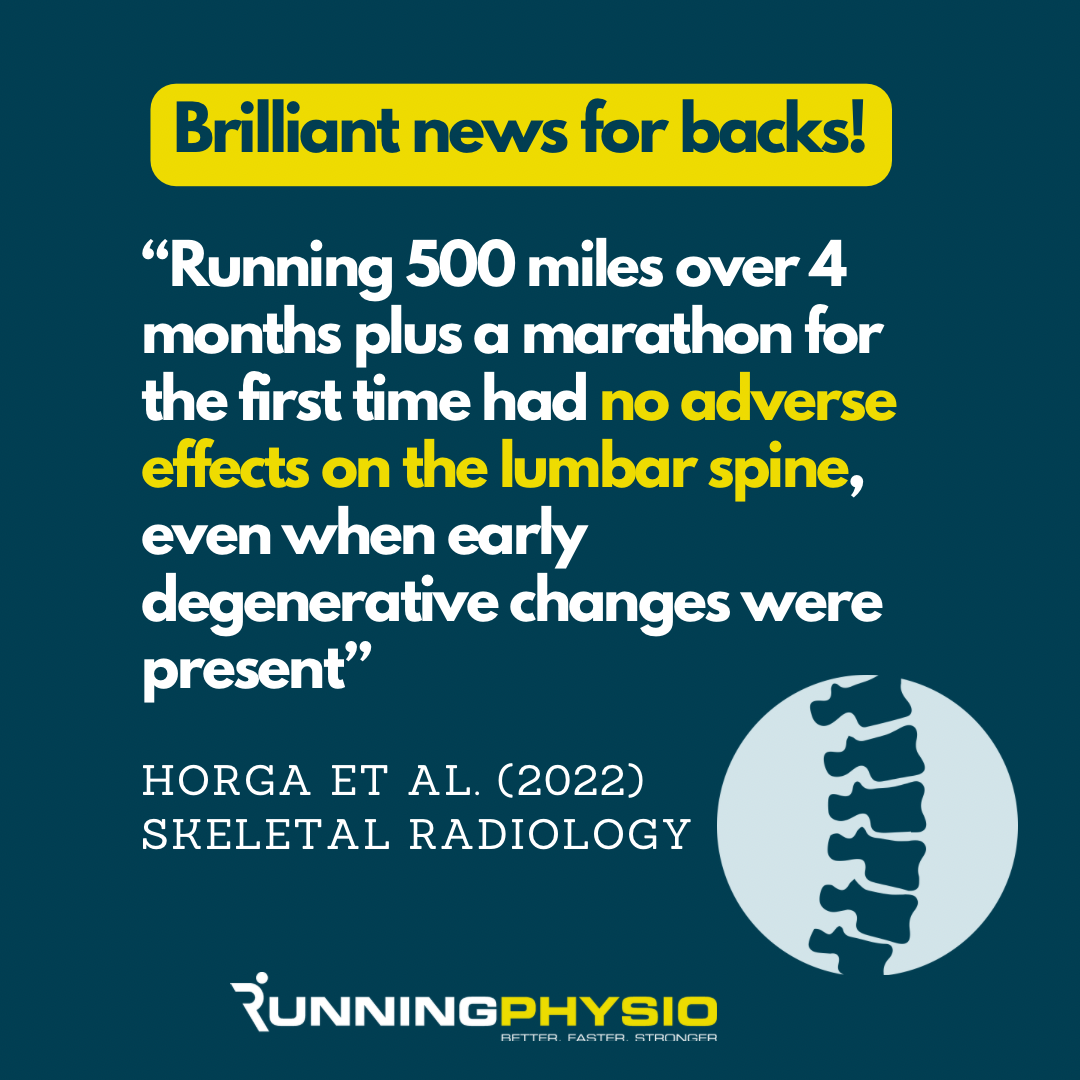Our articles usually are not designed to exchange medical recommendation. When you’ve got an damage we suggest seeing a professional well being skilled. For extra data see out Phrases and Situations.
Low again ache is now the main reason behind incapacity worldwide (Hartvigsen et al. 2018). It may have a long-lasting impact on folks’s lives, psychological well-being and aim actions.
For a few years avoidance of train was advised. I certified at a time when mattress relaxation was nonetheless really helpful! Spines had been thought of fragile and operating was regarded as damaging.
Thankfully considering has advanced and analysis has much more encouraging findings together with 3 key factors that we’ll increase on on this put up:
- Ache-free pathology is frequent and doesn’t normally worsen with operating
- Working can enhance backbone well being
- A run-walk programme may be efficient in treating persistent low again ache
Let’s begin by discussing ‘pathology’ in pain-free runners. I exploit the citation marks there as there’s some debate over whether or not it’s thought of ‘pathology’ when there’s no ache. Horga et al. (2022) discovered that over 60% of asymptomatic runners had disc degeneration on MRI and these findings didn’t worsen regardless of coaching for and finishing a marathon:

Maselli et al. (2020) reported that the prevalence of LBP could also be decrease in runners in comparison with the final inhabitants. Belavy et al. (2017) discovered that operating may very well strengthen the intervertebral discs (IVD) of the lumbar backbone, a discovering supported by Mitchell et al. (2020) who reported higher backbone well being in runners in comparison with non-runners:

These are constructive findings that operating could also be helpful quite than dangerous for the backbone however can it really deal with low again ache? A brand new research has examined this with a randomised managed trial (Neason et al. 2024). Right here’s a abstract of their analysis:

Essential exclusion standards
The authors point out that members on this research tended to have comparatively low ranges of ache and incapacity at baseline. Additionally they excluded these with symptomatic radiculopathy or indicators of cauda equina syndrome. See the paper for a full record of exclusion and inclusion standards.
Working is probably not appropriate for sufferers with extreme, irritable signs, particularly if related to being in additional prolonged, upright positions or affect.
Return to run testing
A take a look at run of as much as 2 minutes was used to assist decide the start line of the run-walk programme. I like this method and it’s one thing I might use clinically:
“Contributors who might jog comfortably for (a) 0-44s began at stage one of many programme; (b) 45-89s began at stage two of the programme and (c) 90-120s began at stage three of the programme.” Neason et al. (2024)
That is just like our return to run testing in Working Repairs On-line the place we recommend a brief take a look at run to evaluate response and information development.
Run-walk programme
I’d suggest studying the paper in full and particularly wanting into the run-walk programme because it’s a pleasant instance of a graded plan that steadily replaces strolling with operating and provides the affected person management of their development.
Be aware the beginning and finish factors of the programme – stage 1 begins with 15 secs of operating and 120 secs of strolling repeated 6 to 10 occasions and executed 3 occasions per week. On common this meant complete operating distance started at 1.1km in week 1 and elevated to 2.7km by week 12. Nevertheless, inside this was important particular person variation.
The important thing level right here is to be lifelike with the place to begin and the way a lot somebody will be capable to progress in 12 weeks, particularly if they’ve been unable to train for a while on account of ache.
Limitations
Each research has limitations, on this one the truth that enhancements didn’t exceed the minimal clinically significant distinction is essential to notice. This will, partially, be as a result of baseline signs. For instance, present ache measured by visible analogue scale (VAS) was 30.80 on common at baseline, it diminished to a median of 14.25 at 12 weeks. This didn’t attain the 20 level discount that might be thought of clinically significant even if ache rating has really halved.
The intervention group additionally obtained optionally available heat up workouts and extra common contact with well being professionals that the management group which can have influenced outcome.
Scientific takeaway
The present proof suggests operating just isn’t dangerous for the again and should enhance backbone well being and assist signs and incapacity related to non-specific low again ache. Nevertheless, it’s unlikely to be appropriate for everybody or each pathology so I have a tendency to make use of 3 standards for steering on when to recommend operating for non-specific low again ache:
- The affected person needs to run and is glad to make use of it as a remedy technique
- Signs are gentle to average they usually can handle a brief take a look at run (e.g. 2 minutes) with minimal ache
- There aren’t any contraindications reminiscent of cauda equina syndrome or extreme, irritable signs which might be more likely to worsen with operating



